
Forest and woodland habitats in Illinois evolved through periodic exposure to natural disturbances such as flooding and fires. Today, people severely limit these necessary disturbances. In addition, invasion of invasive plants and inappropriate timber harvest practices are contributing to changing forest composition and structure. These degraded forest habitats in turn are less able to support an abundance of wildlife.
The Illinois Wildlife Action Plan (IWAP) guides the conservation of wildlife and their habitats for the people of Illinois. The plan focuses primarily on non-game species, especially vulnerable species, known as the Species in Greatest Conservation Need. The IWAP is organized by habitat into seven Campaigns, each with its own strategic plan for increasing the quality and quantity of wildlife habitat in Illinois. These plans are implemented across the IDNR and by partner organizations and agencies, collectively known as the Illinois Wildlife Action Team.
The Forest and Woodland Campaign seeks to maintain and enhance the composition of Illinois’ existing forested habitats and to increase distribution of those habitats in identified priority areas and statewide with many conservation partners. The goals of the campaign are to:
- Implement sustainable forestry practices, including forest stand improvement, prescribed fire, timber harvest, and invasive species control to enhance oak-dominance and maintain understory and herbaceous layer diversity on 1 million acres of forest and savanna/barren/open woodland habitat. Restore and manage small woodlots as open woodlands/savannas as appropriate.
- Increase statewide forest and woodland acreage by 350,000 acres, emphasizing restoration of floodplains and riparian corridors, increasing ecological connectivity among forests and other habitat patches, and reducing fragmentation of forests 500 acres and larger.
- Develop high-quality examples of all forest communities, including all Grade A and B Illinois Natural Areas Inventory sites, restored and managed within all natural divisions within which they occur.
- Manage healthy and well-maintained urban forests and woodlands.









